|
No Kill Huntsville formed in January of 2012. The original group was a couple dozen nonprofit shelter leaders, nonprofit leaders, rescue group leaders and animal advocates. The mission of the organization is, and has always been, to encourage the City of Huntsville to adopt progressive animal shelter programs and to end the archaic practice of destroying healthy and treatable pets using tax dollars. We had no idea if we would succeed when we first met, but we knew we had to try. A number of us had been working independently of each other to seek change and we felt we would do better by combining our efforts. There were numerous places across the country where the lives of shelter animals were being saved and we knew Huntsville could do the same. Prior to the formation of No Kill Huntsville, the live release rate at Huntsville Animal Services had been incredibly low for a very long time. Although most city officials and members of the pubic presumed the shelter would not needlessly destroy animals, that is (unfortunately) exactly what happened for many years. The animals being destroyed were not just those who were suffering or irremediably ill, but animals who were perfect healthy and treatable. We spent approximately a year preparing to make our pitch to the City of Huntsville to adopt the programs and services of the No Kill Equation which we still promote to this day. We had contacts across the country who had used the equation to reform their own communities and we knew the same methods would work here. The equation is a series of programs which work in concert with each other to both reduce shelter intake (what we call “keep them out” programs), to increase shelter output (what we call “get them out” programs) and which both reduce intake and increase output. The genius of the equation is that it can be adopted in any community regardless of resources and bring about change not in years but very fast. Some places have become No Kill Communities literally overnight by using the equation. We realized it would take some more time in Huntsville simply due to the number of animals who had been destroyed over a period of years and due to prior resistance on the part of city officials to embrace the programs themselves and without the need for our political advocacy. We hit some high walls and some big speed bumps along the way. In early 2013, the shelter leadership was offered free help by subject matter experts which we would have paid for. This would have been confidential, hands on help inside the shelter to examine policies, procedures and programs in order to determine how to implement the equation quickly by building on current operations. This help was refused. It was only when we hit that wall that we had no alternative but to take the subject to the public and began our public information campaign which continues to this day. We held a free public workshop, we used the media to reach people, we paid for Lamar billboard space around town to introduce people to the concept of No Kill, we showed a documentary film at Lee High School, we used social media and our fully developed website to reach more people and we engaged in a series of meetings with city officials. Our group became smaller over the years; a core group of 6 members remain to this day. We had a lot of opposition and much of it came from a surprising source: people in the rescue community. It was not easy and we lost friends along the way, something we were told would happen. At one point a shelter employee set up a hate page on Facebook which was encouraged by people in the rescue community as well as members of the shelter staff. The page was ultimately removed with the help of the city. Things began to change quickly in 2014 when we met with newly appointed City Administrator John Hamilton. He was on board with the No Kill Equation from our first meeting with him in March of 2014 and for that we remain incredibly grateful. Due to a combination of animal welfare advocacy, city leadership and public participation, the live release rate at the shelter began to improve over a period of time. It reached the 90% benchmark in 2015 and has remained essentially at that level for the last three years. In April of 2016, we began promoting a CAPA – a Companion Animal Protection Act – which we later called the Huntsville Animal Protection Act. We promoted the HAPA in earnest during 2018 in meetings with city council members and candidates for city council. For us, the HAPA is about maintaining legacy to ensure that the shelter does not go back to the old ways of functioning no matter who leads the city or who runs the shelter. The HAPA would have set measurable standards for the shelter to achieve and would have required certain standards for animal housing, care and placement and prior to euthanizing animals. Because work was already taking place to revise the entire animal code for the city, the city chose to not implement the HAPA and to instead incorporate much of the spirit of the HAPA into the revisions to Chapter 5 of the City Code. This was not the outcome we had hoped for, but it is the outcome chosen by the city. We are left with no alternative to accept the city’s decisions and celebrate the aspects of the ordinance used to change the city code which reflect the intent of the city moving forward and expectations regarding the operation of Huntsville Animal Services. The City's statements of intent are here. The City's expectations of the shelter policies are here. In light of the revisions to the city code, we have suspended our promotion of the HAPA for the foreseeable future. Should a time come when we feel the city is open to codifying more of the aspects of the shelter operation, we will consider promoting the HAPA again.
We will continue to maintain our website and obtain copies of the shelter statistics and euthanasia reports from the City Attorney’s Office each month to ensure the city does not back slide and to continue our work monitoring the number of dogs destroyed for behavior and kennel stress. We will also promote Chipathon events twice a year (in March and July) to encourage people to have their pets microchipped to prevent them from entering the shelter (or to get them back home quickly). We will no longer maintain our Facebook page; it is a 7-day a week platform. It will go dormant unless a time comes when we see the need to use it to reach people. Any questions or comments about our group, the No Kill Equation or the state of animal welfare in Huntsville and Madison County can be addressed to us using our website and our email account. There is still much work to be done in Huntsville and city officials are the first to acknowledge that fact. We hope you will join us in congratulating city leaders on the progress made to date. We also hope you will join us as we continue to hold the city accountable while stepping back into the shadows for now. We are told that the shelter will continue to develop policies and programs which promote life-saving in our community and that we are not limited by the 90% benchmark which ordinarily is an indication of progressive programs. We hope a time comes when the city decides that it can call itself a No Kill community and will do so with pride.
0 Comments
As we wind down 2017, No Kill Huntsville takes a look back at the year as a whole to hit on some of the highlights which have taken place like we did last year. The Bad News • The city has yet to make a public declaration of intent that it will no longer destroy healthy and treatable animals. We were told by City Administrator John Hamilton during a September 2017 meeting that the city has not destroyed any healthy and treatable animals purely for space in three years. Based on this milestone, we see no reason for the city to delay in making a commitment to the No Kill model moving forward. Although the city faced some challenges in 2017 and did not quite match the level of success achieved in 2016, it is in an ideal position to make a public commitment and say that Huntsville is a No Kill Community in both culture and in spirit moving forward. We believe that the city can in good faith commit to a standard and live up to that standard. • We believe that otherwise healthy and treatable dogs are destroyed in the shelter having been labeled as a aggressive or a public safety risk when there may be ways to avoid destroying them. We realize that many dogs do not do well in a shelter environment. We also realize that some dogs are broken and really do present a public safety risk. The National Canine Research Council has stated that, "shelter evaluations may tell us as much or more about the effect of the shelter as they do about the individual dogs. Shelters are noisy, alien environments, filled with strange smells, unfamiliar people, and dogs they may hear, but not see. We should not be surprised that some dogs may. . behave differently when confined in a shelter, with its barrage of stressors that the dog cannot control, than they will in the safe, secure, predictable environment of a home, cared for by people with whom they are able to form positive attachments." We took our concerns about this issue to the city and we offered to pay for a subject matter expert to help the city for free. Our offer was declined. The city has instead decided to retain an expert of its choosing to help train the shelter staff. This training will take place in April. We are hopeful the training will result in fewer dogs being destroyed each month for behavior issues (which are categorized as fearful, aggressive, public safety and high arousal). We will be promoting a fundraiser to help offset costs of the training. • The shelter still has yet to fully embrace the No Kill Equation and develop programs which will serve to both reduce intake and increase output. Many of these programs cost nothing and some actions take very little time. We have included the list of things we have recommended to the city in the Looking Forward section of this blog below. We genuinely hope they will be considered in 2018 or that the shelter leadership will network with national organizations with which they are aligned to seek assistance to fine tune programs. Only when all of the programs of the No Kill Equation are fully embraced with the shelter be able to save more animals. The Good News • The city continues to do an impressive job saving the lives of animals as compared to those saved during the years before we took this issue to the public. We fully realize that saving the lives of animals is incredibly difficult and challenging work and that it is an ongoing struggle. The statistics for 2017 were not quite as good as for 2016. The highlights from our analysis are as follows:
• Plans to improve the shelter building are progressing. The first phase of shelter renovations happened last year with the opening of Cat World. We were told by Mr. Hamilton that renovations will be made to the dog housing area this year which will help reduce the number of dogs getting sick after they enter the shelter and which should also reduce some issues with negative behavior. The kennels in which dogs are housed are currently separated by low walls and fencing. We are told that the renovations will fully enclose each dog kennel. This will allow for dedicated air exchange for each kennel (to avoid the spread of disease and bacteria). This will also reduce the level of stimulation dogs experience from seeing and hearing other dogs to the extent they do now. • Huntsville Animal Services is now active on Petfinder. For a period of time there was no way that someone looking for a pet from the shelter could go to one location to see what pets are available. Some were on a Pet Harbor website and some were on Facebook. We asked the city to consider posting all of the animals on a single website and recommended Petfinder because it is considered the gold standard when people are looking to adopt a pet and want to view pets online. We are hopeful that in the months to come, all of the shelter pets will be shown on Petfinder whether they are in the shelter building or are in foster care. • More pets in our community are microchipped. We held a Chipathon over the summer to promote microchipping and hundreds of pets were microchipped. We are promoting another Chipathon for the month of January of 2018. The goal of these events is to get more pets microchipped so they can be returned home quickly and spend either no time in the shelter or less time in the shelter. • The shelter now has a sound system just for the animals. A Facebook group called Lost and Founds Pets of Huntsville/Madison County, led by Jeananne Jackson, promoted a You Caring Fundraiser to get a sound system installed in the shelter to help calm the shelter animals. The system was installed in July at no cost to the city. It plays soft rock during the day and classical music at night. Studies have shown that shelter animals show signs of reduced anxiety and anxiety-related behaviors such as barking, scratching, pacing and whining when exposed to music. Looking Forward No Kill Huntsville has been in a monitoring mode of sorts during this year and we plan to continue in that capacity in 2018. We look forward to the facilities upgrades which are being planned and we look forward to the training which will take place in April to help the shelter do a better job of evaluating dogs toward keeping more of those dogs alive. We have made a number of recommendations to the city regarding community outreach and program development. Although we have been told that our suggestions are considered after those of employees and volunteers, we hope the shelter leadership will consider implementing those programs which do not cost more, which take very little time and which would not require additional staffing. Some of our recommendations are listed here. If you support any of our recommendations, we ask that you communicate that support to Mr. John Hamilton and to Dr. Karen Sheppard. • Hold monthly community outreach meetings in the city council districts and county commission districts (one meeting a month in a different location) to address issues in those geographic areas to help reduce shelter intake while increasing adoptions through direct contact with the public being served. Many people don’t think about the shelter operation or how it is affected by their personal behavior. Community outreach can be used to educate the public to make better choices while making it clear what services the shelter does and does not provide. • Consider enacting a Companion Animal Protection Act like that enacted recently in Muncie, Indiana and which has also been acted in places like Austin, Texas, St. Paul Minnesota and the State of Delaware. A CAPA would be an ordinance to codify some of the standards for the shelter, regardless of who oversees the shelter. Enacting a CAPA would serve to preserve the legacy of Mayor Battle and other city leaders moving forward by ensuring the shelter does not destroy animals when there is open kennel space, by ensuring the shelter does not destroy animals without first networking with rescue groups and by ensuring the live release rate does not fall below 90% (among other provisions). • Improve the method by which adoption surrenders are handled so there is a mechanism for adopters to return animals within a set period of time rather than having them go to rescues for help or otherwise feel compelled to abandon them (which is illegal). • Improve surrender counseling to work harder to keep pets in existing homes and establishing a waiting list for owner surrenders (as opposed to just turning people away). • Hold periodic off site adoptions at city parks in various locations to interact with a wider segment of the public and make it easier for people to adopt a shelter pet. (An off-site event was held on December 29th at Big Spring Park and a small number of dogs were adopted.) • Stay open late one more night a week (in addition to Tuesday night) to make it easier for owners to find lost pets or adopt. • Implement Pets for Vets and Seniors for Seniors programs to reach certain segments of the population and to place larger dogs and older animals. • Implement a Pet Help Desk managed through a combination of email and phone using volunteers to help augment the staff in order to help people keep pets in their homes and out of the shelter. • Enact city anti-chaining and humane tethering ordinance similar to the one enacted in Arab last year to reduce problems associated with resident dogs who are not properly socialized to people or who may be subject to abuse and neglect (causing them to end up in the shelter). No Kill Equation Report Card
As we wind down 2016, we wanted to take a look back at the year as a whole and hit on some of the highlights which have taken place. We’ve categorized them into "bad news" and "good news" categories. The Bad News 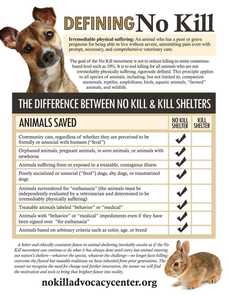 • We are still not a no kill community as a philosophical way of functioning because the city has yet to make a commitment to no longer destroy healthy and treatable animals. When we asked for that commitment during a meeting with City Administrator John Hamilton in June, we were told "no. The city will not commit to that." We presume this decision serves to give the city an "out" should some crisis arise or should there be some collapse of programs which have led to the current level of progress. We still believe that the city is in a perfect position to make a commitment in light of the progress which has been made. We do believe that the shelter needs to develop a disaster plan in the event of a mass-intake event (from a collector, puppy mill or dog fighter), but we believe that the city can in good faith commit to a standard and live up to that standard. • Healthy and treatable animals are still destroyed in the shelter. We honestly do not know how many savable animals were destroyed this year, but we have no doubt that this practice continues on at least a limited basis based on posts on the shelter's Facebook page and based on information we have from sources inside the shelter. We think that the number of healthy and treatable animals being destroyed is incredibly small compared to the numbers from the past, but the practice has not ended completely. The problem with this is that the shelter is reporting on euthanasia reports that animals were destroyed for reasons related to health or behavior. Not one "euthanasia" report we obtained this year honestly reported that healthy dogs were destroyed for space. The issue with this lack of transparency is that people presume ours is a no kill shelter when pets who are simply lost may actually still be at risk. Some would argue that we should not focus on individual instances of dogs being destroyed for space. Our counter to that argument is that it may not seem important until the dog destroyed for space is your beloved dog who simply got out of your fenced yard accidentally when you were out of town on vacation.  • Dogs continue to get sick after entering the shelter. The shelter has a history of dogs entering the shelter healthy and then acquiring upper-respiratory problems dating back many years. We have been told on multiple occasions that the inability to keep dogs healthy relates to the HVAC system. Our reply to that has been pretty clear: fix it. We see it as part of the ordinary functioning of any city department to seek and acquire funding for facilities upgrades. There have been no upgrades to the shelter related to the issue of sick dogs even though the problems have existed for years. Because the shelter is managed by a veterinarian, we know there is a public expectation that animasl will not get sick after entering the building. • People from outside our community continue to revise history, doing so unfairly and to the detriment of communities like ours. We have blogged on the topic of our history a few times this year not so much for the benefit of Huntsville but for the benefit of other places. We are contacted on a regular basis by people from other states asking how Huntsville got to this point and what steps we recommend others take. Florida, Illinois, California, Hawaii. As grassroots advocates, we do our best to help people not only understand what steps we took to help ours work toward becoming a no kill community, but what mistakes we made along the way. As Ryan Clinton, the Founder of FixAstin once said, "it's important not to change history because then you learn the wrong lessons." An organization called Target Zero which was active here for less than a year (and in a remote capacity) has declared that it got Huntsville "to zero" in less than a year and they can do something similar for other places as it goes around the country seeking new clients and using our city as an example. Target Zero did play a role here. What Target Zero fails to tell people is that by the time they arrived at our airport for a 2-day visit, the live release rate had gone from 34% to more than 70% in less than a year, all without their involvement and after we took the no kill subject to the public and to a new city administrator. Change was already taking place. There will always be disagreement about what led to that change. We are absolutely certain that but for the advocacy of No Kill Huntsville very little would have changed at all and the city may still be destroying the majority of the animals in the shelter while being answerable to no one. We point this out not related to a desire to receive any type of credit. We really could care less about that. We talk about it because we don't want people in other places to think our history lacked conflict or think that Target Zero saved us from ourselves. The Good News 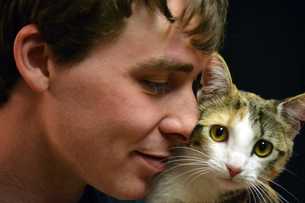 • More animals are being saved than at any time in the history of the city. When we look at the statistics for the shelter for this year (through November), we cannot help but to be impressed. Although the numbers vary by month, the city has managed to keep the live release rate above 90% for all but one month and that month was just below 90%. While we do not agree that a live release rate of 90% = a no kill community (as some believe), we are sincere in our applause and congratulations to the shelter leadership and the city leadership in achieving this progress. As recently as 3 years ago, only half of the animals entering the shelter made it out alive. This progress demonstrates that the shelter culture has changed drastically. The shelter is no longer a place of despair and death and is now a place of hope and new beginnings. • Dogs have a better chance of being evaluated fairly. We have been tracking data regarding dogs destroyed in the shelter for more than 2 years, using reports we seek and obtain through the Alabama Open Records Act. We saw some disturbing numbers related to dogs being destroyed for a variety of behavioral issues from aggression to fear to high arousal. After recommending to the city for some time that it engage the services of someone who could train the staff and volunteers on evaluating dogs in a shelter environment, that training happened in March of this year. The city secured a grant and was able to bring Diane Blankenburg -of Humane Network - back to town as well as Kelley Bollen of Animal Alliances who has a Master's Degree in Animal Behavior and who is the former Director of Behavior Programs for the Shelter Medicine Program at Cornell University College of Veterinary Medicine. The shelter staff and volunteers were provided with 2 days of training on how to assess shelter dogs and members of our coalition were also invited to attend. We believe that the decrease in the number of dogs being destroyed for behavioral issues relates directly to this training. • Cat World is open and the shelter is getting upgrades. Thanks to a grant from Petco, the shelter converted what was a classroom into an area called Cat World. The cats are now housed in new and better kennels and are no longer sharing space with dogs (which can add to their stress levels). The newly renovated space has its own ventilation system which will keep the cats healthier. Removing cats from the traditional shelter area also means that the city can proceed with plans to renovate the area where dogs are housed, hopefully taking positive steps to house dogs more safely and to prevent dogs from getting sick. We were told by John Hamilton earlier this month that the Cat World project was phase 1 of a series of phases to upgrade the building. Mr. Hamilton said, "we are currently working on design for the rest of the building and I would expect the next round of construction to start by mid-2017. In addition to better segregating and ventilating the dog spaces, we also need to address the veterinary space and the laundry/housekeeping spaces." Looking Forward No Kill Huntsville has been in a monitoring mode of sorts during this year and we plan to continue in that capacity in 2017. We look forward to the facilities upgrades which are being planned and we look forward to the city embracing more programs of the no kill equation which can serve to both reduce shelter intake and increase shelter output. There are some who say that becoming a no kill community isn’t possible. That it costs too much money or that it leads to institutionalized hoarding or lack of adequate care. Those naysayers need look no further than to Huntsville, Alabama, to see what happens when the public and municipal leaders come together and commit to doing better for the sake of the companion animals we value in our society. It can be done. Is it hard work? Absolutely. But we presume that those who lead our shelter, work in our shelter, volunteer at our shelter, donate to our shelter, foster our shelter animals and adopt from our shelter would say that every action taken to save a life is worth the struggle and is incredibly rewarding. (images courtesy of the No Kill Advocacy Center, Bryan Williams and Peace and Paws Dog Rescue)
For those of you who have come to our website and are wondering if we still exist, yes. We are still here.
Late last year we made a collective decision to change our engagement in the community as a result of the fact that Huntsville Animal Services had made quite a bit of progress in saving animals. Although we still have some concerns regarding program development and sustainability, there is little to be gained by repeating ourselves for the sake of emphasis. We have made a number of recommendations regarding our concerns and have been told that the city "is and will continue to engage with industry experts in shaping the policies and procedures used in the shelter. We are extremely pleased with the progress. . .over the last couple years and confident that conditions are being set to continue that progress." We are essentially in a holding pattern while we wait to see what happens in the months to come. A recent post by the Huntsville Animal Services on Facebook indicated that during 2015, the shelter "housed right at 3,218 dogs and 1,973 cats (5,191) releasing alive right at 2,738 dogs and 1,812 cats (4,550) and having still 287 pets in our shelter and foster home program." We have requested statistics for the year and have requested copies of records related to dogs destroyed in the last three months of the year so we can continue our analysis of the reasons why dogs are destroyed. Once we have those records, we will post them on our website. We understand that there are many people in our community who are still angered by or unhappy with our advocacy. Some of them are with local rescue groups, some of them are shelter volunteers and some of them have chosen to go on the attack against us personally for our advocacy. As much as we find this type of behavior unproductive (and in many cases libelous) there is little we can do to stop it and we simply will not be baited by it. We have much better ways to spend our time than to try to engage in discourse with people who attack the messenger while completely losing sight of the message. We did not relish having to come together to seek better for our community in the first place. We are all incredibly busy and advocacy takes a toll in terms of time, money and emotional energy. There are no days off. We have no regrets for having been the boat rockers for the sake of the lives of companion animals and the people who live and work here. We would ask those who find our advocacy too outspoken to consider this one fact: if local officials had chosen to embrace no kill philosophies years ago and on their own after having been introduced to those philosophies, our coalition never would have been necessary in the first place. As the saying goes, "we didn't start the fire." We hope you will stay tuned in the months to come as we sit back, watch what happens and continue in our role of keeping the city honest. Will we become a no kill community in 2016? We certainly hope so.
When our coalition first formed in January of 2012, we had one goal in mind: to speak with one voice toward making ours a no kill community - a place where healthy and treatable shelter animals are not at risk and are not destroyed using our tax dollars. We developed a Facebook presence in April of 2012 in order to reach more people in the community and share our vision of Huntsville as a no kill community. We have always sought to become irrelevant not because of lack of interest, but because we simply are no longer needed in this particular advocacy role.
The City of Huntsville is nearing the end of the most successful year of animal sheltering in the history of the city. The numbers for the entire year have yet to be calculated; we presume that the live release rate will be near 90% and may even exceed that percentage. The city has openly stated that it hopes to do even better in the coming year and city leaders are clearly energized about the public’s response to calls for community involvement in saving shelter pets. As we begin the new year, we have moved away from Facebook and reverted to our primary means of communication which is our fully developed website. We will be blogging from our website periodically in order to keep supporters posted on news of interest and the latest local developments. We remain hopeful that the progress achieved by city officials to date can be sustained. We look forward to a time when the city makes a public declaration that it plans to become a genuine no kill community and that healthy and treatable shelter animals are no longer at risk in our municipal shelter under any circumstances. We still have some concerns about program development, but we can envision no circumstances under which the city would revert back to the old ways of functioning. We hope you will stay tuned as we begin a new and exciting chapter in the history of Huntsville and Madison County and as this community demonstrates to the entire region what can happen when we have faith in the compassion of the animal-loving public. The next logical step following a public declaration of intent is for the city to codify the manner in which the municipal shelter operates so that progress can be sustained not just for the short-term, but for years to come by enacting a Companion Animal Protection Act. More information on this and other programs that sustain the progress and can better serve the animals and the public can be found on our website. Will 2016 be "the" year we become a no kill community? We have faith in those who lead us and in our community to do just that. When city officials were first introduced to the no kill programs we promote in equation form in late 2008, the live release rate at our municipal shelter was 25%. Three out of every 4 animals were destroyed regardless of health or disposition. When we formed our coalition in early 2012, the live release rate had risen to 34%. We consider this a dismal number and are truly glad it is now just part of the past
The live release rate at the municipal shelter was over 96% in the month of October and we suspect the November numbers will be similar, This is a stellar achievement and one which should be a great source of pride for local elected and appointed officials, city employees, rescuers, volunteers and the animal-loving public. Just a few short years ago, many in our community felt we just could not do better for whatever reason. Time has proven that position to be wrong. As has been the case in many communities brave enough to try something new, time has proven that we are, in fact, capable of change and that our community is, in fact, compassionate enough to make better choices. More than 100 shelter animals were adopted out in a single day on November 30th. When a bed drive was launched to help shelter dogs, the goal of 80 beds was met in less than 4 business days. Those facts alone say a lot about our community and the capacity for greatness. The road to change is never easy. It comes with conflict, lost sleep, hurt feelings and in the case of the no kill movement, it often results in a great deal of opposition. This may seem illogical to many of you. As we were asked at our no kill workshop in the summer of 2013 at the downtown library, "who could possibly object to saving the lives of homeless pets?" Exactly. If someone had told the members of our group in January of 2012 that Huntsville would achieve live release rates above 95% but that it would take us being made out to be the bad guys in the process, each and every one of us would have signed on for those terms. Because, you see, this has never, ever been about us as individuals and has always been about pushing for better for our homeless pets and our community. Whether you think our coalition has had anything to do with change here or not, the reality is that we are now a much different community than we were four years ago in terms of how many shelter pets are saved. As we near the end of 2015, we remain hopeful the shelter progress achieved to date can be sustained. We challenge city officials not only to keep the live release rates close to those achieved in recent months, but also to make that final push and commitment to make ours a no kill community by publicly declaring that healthy and treatable shelter pets are no longer at risk under any circumstances. We invite all of you to learn more about what is taking place in our community related to the municipal animal shelter, about your your own behavior affects what happens in the community and about what you can do personally to be part of making ours the no kill community we know we can be. |
No Kill Huntsville
Keep up with our updates and latest news regarding Huntsville becoming a no kill community. Archives
January 2022
Categories
All
image courtesy of Terrah Johnson
|
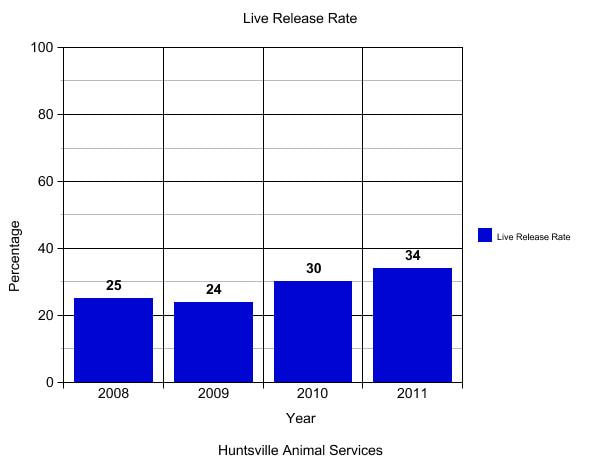
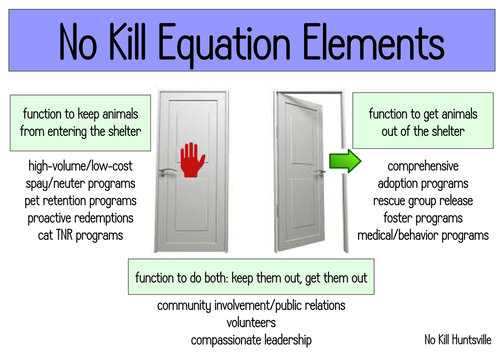
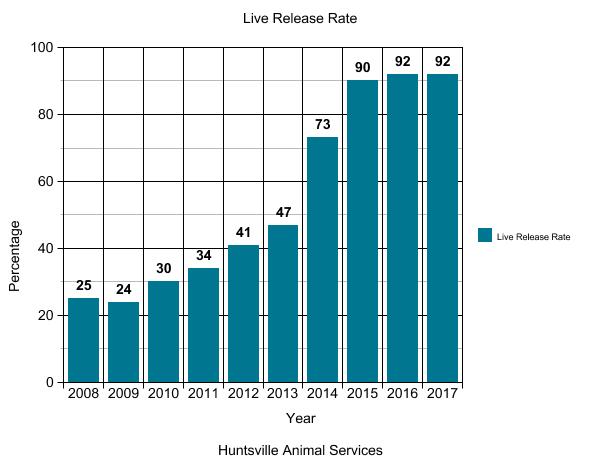
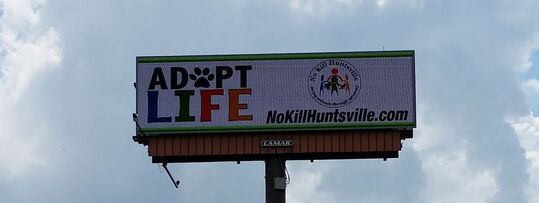
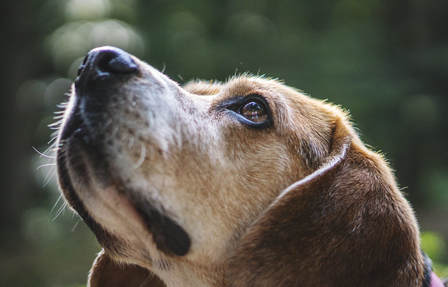



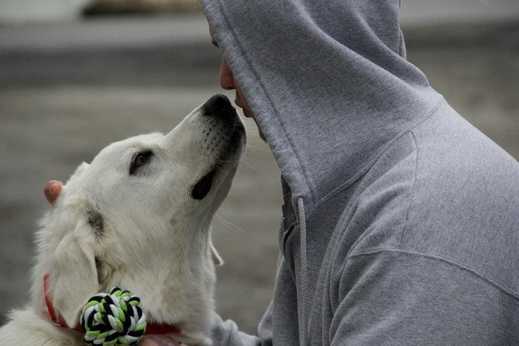
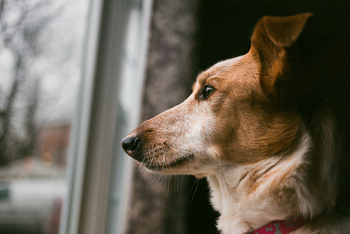
 RSS Feed
RSS Feed
